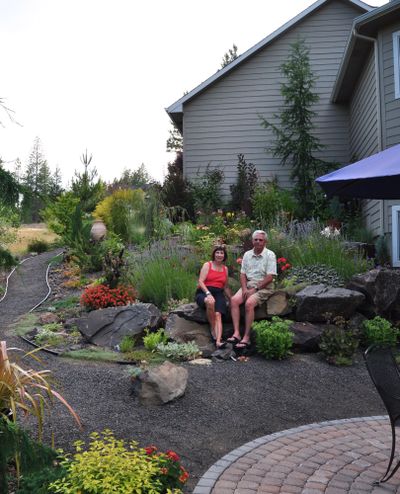Winning garden is place where Mediterranean, Palouse intersect

Truly beautiful gardens are a blend of plants, their setting and the heart and talent of the gardeners.
All this comes together in John and Maralee Karwoski’s garden in Spokane’s Eagle Ridge neighborhood. As co-chair of the Manito plant sale and a WSU Master Gardener, Maralee knows her plants, and that means that many unique trees, shrubs, perennials and grasses find their way into their landscape. John adds his talents for building garden benches and other whimsical garden art out of old barn wood. Together their efforts won them the July Garden of the Month award from The Inland Empire Garden Club.
The Karwoskis’ garden is on a very steep, dry site that limits where they can plant. As a result, the garden is in a narrow band around the house. The back half of their property has intentionally been left in native grasses, shrubs and pines in keeping with the open space tradition of Eagle Ridge.
When they bought their house in 2004, it was still under construction, so they basically started with nothing but the rough site and a spec front yard plunked in by the contractor. “We tried to get them to not install the front landscaping,” said Maralee. “But it was required by the neighborhood.”
They took on the tough challenge by designing a garden that took the conditions in stride. “We blended a hardy Mediterranean-style garden into a Ponderosa woodland,” said Maralee. They installed an extensive drip irrigation system to water the plants so there wasn’t any hose-dragging on the steep site.
Traditional Mediterranean gardens have a number of plants that aren’t hardy in our climate. That meant it was necessary to find substitutes, a challenge that Maralee, with her extensive knowledge of plants and design, relished. After studying the forms and textures of the traditional garden plants, she began selecting hardy plants with many of the same characteristics.
The result is a wonderfully eclectic collection of plants that really makes you feel are somewhere on the Mediterranean coast. On the hot dry south side, rugged boulders set to hold back the slopes hold back collections of lavender, sage, Echinacea, Russian sage, roses, herbs and a stunning tiger-eye sumac. Pyramidal conifers like Alaskan cedar and fir serve as the evergreen component. Hardy gray-green Russian olive replaces the traditional olive found in Mediterranean gardens.
On the cooler north side, a gravel path winds through collections of hosta, rhododendrons, heuchera and many other unusual plants leaves the walker feeling much cooler after being on the warm side of the house. The garden is the perfect frame for a view of a grassy meadow below the garden that meets the native pine forest.
To enjoy it all, in the narrow space at the back of the house they have tucked a stone patio below the deck where they can enjoy watching the local wildlife as they eat dinner. If the weather is bad, they move onto the covered deck and enjoy the view from comfortable chairs.